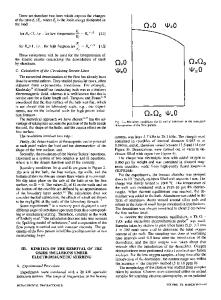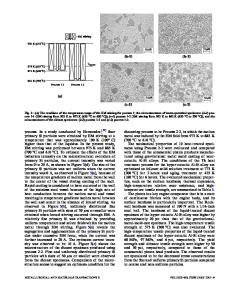Investigating the micro-structures of A356 semi-solids based on electromagnetic stirring currents and crucible materials
- PDF / 1,047,741 Bytes
- 7 Pages / 595.22 x 842 pts (A4) Page_size
- 109 Downloads / 318 Views
DOI 10.1007/s12206-020-0831-y
Journal of Mechanical Science and Technology 34 (9) 2020 Original Article DOI 10.1007/s12206-020-0831-y Keywords: · Semi-solid materials · Microstructures · Electromagnetic stirring · Crucible materials
Investigating the micro-structures of A356 semi-solids based on electromagnetic stirring currents and crucible materials Min Heo1, Chul Kyu Jin2, Joong Suk Roh3 and Chung Gill Kang4 1
Correspondence to: Chul Kyu Jin [email protected]
Citation: Heo, M., Jin, C. K., Roh, J. S., Kang, C. G. (2020). Investigating the micro-structures of A356 semi-solids based on electromagnetic stirring currents and crucible materials. Journal of Mechanical Science and Technology 34 (9) (2020) ?~?. http://doi.org/10.1007/s12206-020-0831-y
Received March 26th, 2020 Revised
June 15th, 2020
Accepted July 16th, 2020 † Recommended by Editor Hyung Wook Park
2
School of Mechanical Engineering, Pusan National University, Busan 609 735, Korea, School of Me3 chanical Engineering, Kyungnam University, Changwon 51767, Korea, Company of Hanju Metal, Won4 san, Ulsan 75320, Korea, School of Mechanical Engineering, Pusan National University, Busan 609 735, Korea
Abstract
In this study, the characteristics of microstructures in a liquid state were investigated; these microstructures were produced via electromagnetic stirring using semisolid forming methods. The spherical structures were studied under the application of variable currents using a large electromagnet in order to stir molten metal with a maximum weight of 520 kg, which is a range that is commonly used in industries. Moreover, the changes in the microstructures of metal slurries were investigated based on the type of crucible used. Additionally, the size and roundness of the primary α-Al particles were analyzed according to the variable input current. Crucibles composed of ceramics, SUS304, and HK40 were used for the experiment to measure electromagnetic forces. For the HK40 crucible, the average size of the primary α-Al particles was 67.8 μm and their roundness was 2.4. When a current of 120 A was applied, these values were 21.40 μm and 2.3. Thus, it could be concluded that the stirring was well-executed under an input current of 120 A.
1. Introduction
© The Korean Society of Mechanical Engineers and Springer-Verlag GmbH Germany, part of Springer Nature 2020
Recently, significant efforts have been devoted toward research on high-quality and lightweight products in Al-based electronic and aerospace industries, particularly in the automobile industry [1-4]. Consequently, there has been an increase in the consumption of lightweight materials with the aim of improving fuel efficiency and performance. Accordingly, research on Al alloy, which is a well-known lightweight material, has progressed. Lightweight products are specifically manufactured via die casting or squeeze casting. However, the products obtained by using these methods have poor toughness and durability because of the formation of dendritic structures during the solidification proce
Data Loading...










